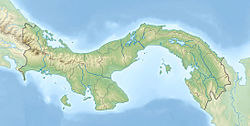| Tobabe Formation | |
|---|---|
| Stratigraphic range: Messinian | |
| Type | Formation |
| Lithology | |
| Primary | Conglomerate |
| Other | Sandstone |
| Location | |
| Coordinates | 9°06′N81°48′W / 9.1°N 81.8°W |
| Approximate paleocoordinates | 8°54′N80°54′W / 8.9°N 80.9°W |
| Region | Bocas del Toro |
| Country | Panama |
| Type section | |
| Named for | Tobabe |
The Tobabe Formation is a geologic formation in Panama. The conglomerates and sandstones preserve fossils dating back to the Messinian period. [1]
